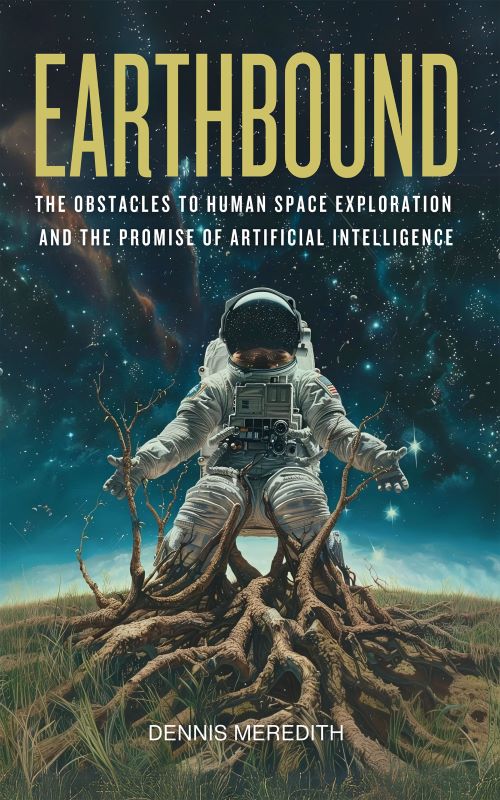Cosmic cheerleaders have offered many rationalizations—some very alluring—for human deep-space exploration. But they are hollow. They are generally vague, hand-waving arguments; and when their merits are closely examined, they lack substance. One might compare them to hollow chocolate Easter bunnies—appetizing on the outside, but with nothing on the inside. These motives can be characterized as:

Aspirational: “Human space missions should be undertaken just as mountains are climbed: because they are there.” However, as Earthbound shows, deep space is an unscalable mountain. The aspirational argument will ring especially hollow in the face of deep-space exploration’s ultimate failure.
Inspirational: “Students are inspired to careers in science and engineering because of the space program.” It has been argued that the new generation “deserves” an inspirational Mars mission to spark interest in science. However, a 2014 report on human spaceflight by the National Research Council cast doubt on this rationale, concluding that:
The challenge and excitement of space missions can serve as an inspiration for students and citizens to engage with science and engineering although it is difficult to measure this [emphasis added]. The path to becoming a scientist or engineer requires much more than the initial inspiration. Many who work in space fields, however, report the importance of such inspiration, although it is difficult to separate the contributions of human and robotic spaceflight.
What’s more, other fields, such as the environment, can be just as inspiring; and they have the advantage of offering real-world benefits, rather than the literal pie-in-the-sky of the human deep-space program. In fact, STEM recruitment programs that offer education and economic incentives are more effective than those that seek only to inspire. Indeed, when the overwhelming human cost of deep-space missions becomes clear, will they still be inspirational?
Emotional: “We have a basic emotional need to see members of our species overcome the obstacles of the space frontier.” This need has no rational basis, as authors Donald Goldsmith and Martin Rees write in their book The End of Astronauts:
Our emotional preference for human rather than robotic explorers rests on sentiments that each of us formed before we ever attempted to use reason as a guide. These attitudes will persist, hardly capable of change or refutation whatever outcome we may desire.
Genetic: “We evolved an innate drive to explore as a basic feature of our species.” Goldsmith and Rees do not agree, writing:
The desire to explore is not our destiny, nor in our DNA, nor innate in human cultures. The first assertion has only mysticism in support, the second has no genetic evidence, and the third encounters negative evidence around the world. If sending humans to Mars were “our destiny,” we would have no reason to hurry down this path, as many insist we must, since we would be sure to get there eventually.
Generating spinoffs: “Development of space missions has driven the creation of new technology, i.e., spinoffs.” While space exploration has driven some technologies, the overwhelming number of space-related technologies—materials, electronics, etc.—had their fundamental origins elsewhere. And while NASA lists numerous spinoffs from its missions, those products and technologies could have been spawned through more robust funding of basic and applied research, as well as during a commercial development process. More generally, some contend that the drama and romance of space travel act as a general propellant for technological advance, creativity, and innovation. In reality, that driving force is the inherent human curiosity and industry. There was no human space program in Curie’s day, or Edison’s, or Einstein’s. As the 2014 NRC report concluded:
. . . even if NASA’s human spaceflight activities have had a substantial favorable effect on US technical, industrial, and innovative capabilities, it is difficult or impossible to ascertain whether similar effects could have resulted from similarly large R&D investment by other federal agencies.
Exploration: “The search for life on Mars, as well as human exploration of the moon, Mars, and asteroids will yield a fount of new knowledge.” Indeed, discovery of a “second genesis” on Mars would have profound scientific and societal impact. However, such a search need not require transporting and maintaining fragile humans millions of miles in hazardous, even lethal, conditions. It can be done more safely and cost-effectively by robotic landers and sample return missions.
Economic: “Space manufacturing and, asteroid mining could yield enormous profits.” However, the economic case for such endeavors is doubtful at best. And should manufacturing and mining prove economically feasible, they could be done more safely and cost-effectively by robotic systems.
Job creation: “Space exploration will create thousands of jobs.” But so would the same amount of money expended on infrastructure, environmental restoration, basic research, and countless other endeavors in which the product was not literally shot into space.
National Security: “Having astronauts in space is critical to national security.” The NRC report declared:
Space-based assets and programs are an important element of national security, but the direct contribution of human spaceflight in this realm has been and is likely to remain limited.
However, the report did note that:
An active U.S. human spaceflight program gives the United States a stronger voice in an international code of conduct for space, enhances US soft power, and supports collaborations with other nations.
Competitive: “China has committed to mounting an aggressive deep-space exploration and colonization program, and the US risks losing that new space race.” However, such missions are doomed to failure by massive cost, logistical barriers, and low human survivability. Nevertheless, there is a distinct likelihood that the US could be drawn into a space race, despite these realities. The political baggage of being accused of letting the US lose could be too great. And the commercial baggage of losing out on resource access could be onerous.
Species Survival: “Given that humans are making Earth unlivable, survival of the species demands colonizing space and other worlds.” However, as this book shows, there is no possibility of humans surviving, much less thriving, in space or on Mars.